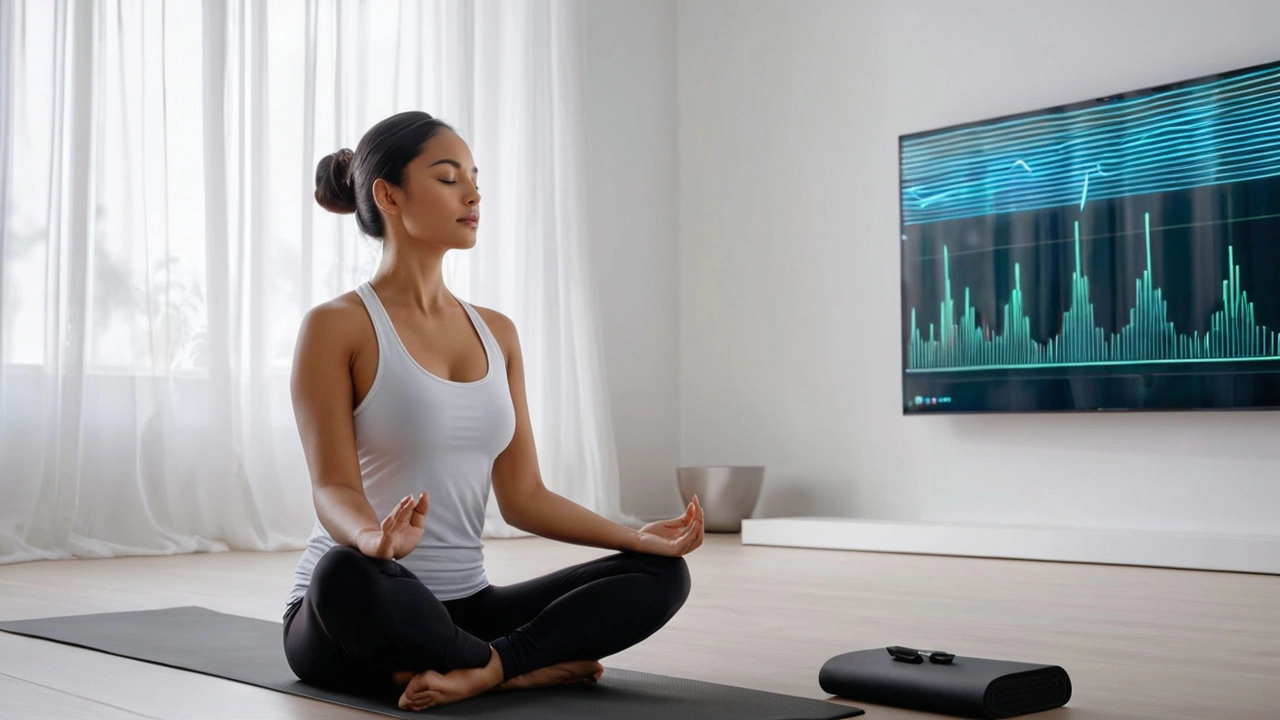Our minds and bodies are deeply interconnected, a relationship that can be harnessed for better health through a technique called biofeedback.
Biofeedback involves monitoring your body's functions, such as heart rate and muscle tension, to gain control over them. This method can be particularly useful for stress management, pain relief, and improving overall well-being.
Imagine having the power to influence physiological processes that usually happen automatically. This article delves into the concept of biofeedback, exploring how it works, the benefits it offers, and practical tips for getting started.
What is Biofeedback?
Biofeedback is an innovative therapy that has bridged the gap between technology and the body's natural processes. It involves using electronic devices to monitor physiological signals like heart rate, muscle tension, skin temperature, brain waves, and more. By making these signals visible and understandable, individuals learn to control involuntary functions, often to improve health and wellness.
The concept isn't entirely new. In the 1960s, researchers began to explore how feedback from biological processes could empower people to make subtle, purposeful changes in their bodies. The principle is straightforward: if you can monitor a certain function, you can learn to regulate it. This approach has proven effective in various settings, from clinical environments to at-home practices. Athletes use biofeedback to optimize performance, while patients with chronic pain might use it to find relief without medication.
A typical biofeedback session involves attaching sensors to the skin. These sensors pick up physiological data and transmit it to a monitor that displays the information in real-time. Visual and auditory cues help the individual understand their body's responses to different stimuli or stressors. For example, you might see your heart rate spike during a stressful thought and then learn breathing techniques to bring it down.
"Biofeedback allows an individual to bring their subconscious physiological processes under voluntary control," says Dr. John Basmajian, a pioneer in the field.
One fascinating aspect of biofeedback is its application in mental health. It's been used to treat disorders like anxiety, ADHD, and PTSD. By recognizing how their body reacts to stress, individuals can develop healthier coping mechanisms. The technique encourages a proactive approach to mind-body health, making it a valuable tool in modern medicine.
The effectiveness of biofeedback has been validated by numerous studies. For instance, a study published in the Journal of Clinical Psychology found that patients using biofeedback for anxiety had significant reductions in symptoms. Another study in the Journal of Pain Research showed that biofeedback could be as effective as medication for chronic pain management.
In summary, biofeedback is a compelling method for mastering your body's intricate systems. With the help of technology, it transforms mysterious internal processes into tangible data, offering you the insight needed to make meaningful changes. Whether you're looking to manage stress, improve mental health, or enhance physical performance, biofeedback provides a hands-on approach to achieving your wellness goals.

How Biofeedback Works
The process of biofeedback is both functional and fascinating. At its core, biofeedback uses electronic devices to measure physiological processes that we're usually unaware of. These processes include heart rate, muscle tension, skin temperature, and even brain waves. By converting this data into a visual format, the user can see real-time feedback and, with practice, learn to control these physiological activities. This capability helps manage stress, reduce pain, and optimize overall well-being.
When you engage in a biofeedback session, sensors are attached to different parts of your body depending on what you are trying to monitor or control. For instance, an electromyogram (EMG) may be used to measure muscle tension, while an electroencephalogram (EEG) records brain waves. These sensors send signals to a monitor that displays the activity as graphs or sounds. By observing these outputs, users can start identifying when they are tensed or relaxed and learn methods to alter these states consciously.
To make it simpler: imagine you are stressed and your heart rate is high. The sensors detect this and show the elevated heart rate on a screen. By employing techniques like deep breathing or meditation, you can watch the heart rate decrease in real-time as you calm down. This visual cue reinforces the mind-body connection, making it easier to control physiological responses during real-world stressors.
"Biofeedback helps people alter their physiological activity to improve health and performance," states the Association for Applied Psychophysiology and Biofeedback (AAPB).
Biofeedback is used for various treatments. From managing chronic pain to reducing anxiety, the applications are wide-ranging. It has also been employed to improve athletic performance and assist in physical rehabilitation. The practice doesn't offer overnight solutions but motivates users to become active participants in their health and wellness journey.
Different biofeedback machines serve different purposes. Some are complex and only available in clinical settings, while others are simple enough for personal use at home. Wearable devices are growing in popularity, often syncing with smartphones for continuous monitoring. This portability and ease also make it convenient for people to incorporate biofeedback into daily routines, enhancing their ability to manage stress and stay aligned with their health goals.
Specialists often use biofeedback along with other treatments. For instance, combining biofeedback with cognitive-behavioral therapy (CBT) has shown promising results for individuals with anxiety disorders. In this integrated approach, biofeedback provides the quantitative data, while CBT addresses the patterns of thought associated with physical symptoms.
Individuals vary in their responses to biofeedback training. While some may see quick improvements, others might require longer to experience significant changes. However, with dedication, most people can gain better control over their physiological responses, leading to improved mental and physical health.
| Type of Biofeedback | Purpose |
|---|---|
| Electromyography (EMG) | Muscle Tension |
| Electroencephalography (EEG) | Brain Waves |
| Heart Rate Variability (HRV) | Heart Rate |
| Galvanic Skin Response (GSR) | Skin Temperature |
Mastering the art of biofeedback takes time and consistent practice. However, the benefits are well worth the effort. Individuals who stick to biofeedback training often find themselves leading more balanced, peaceful, and healthy lives. Whether you're looking to improve athletic performance, manage chronic pain, or just find a way to relax, biofeedback offers a fascinating and effective solution.

Benefits of Biofeedback
Biofeedback is not just a futuristic gadget or a passing trend; it has substantial, science-backed benefits for both the mind and body. One of the most well-known advantages of biofeedback is its ability to manage stress effectively. Stress can wreak havoc on your daily life, impacting everything from your immune system to your mental health. By using biofeedback, individuals can learn how to control their stress response, reducing the production of stress hormones like cortisol. This can improve sleep quality, boost the immune system, and even enhance emotional well-being.
Moreover, biofeedback can be a game-changer for chronic pain sufferers. Conditions like migraines, tension headaches, and even fibromyalgia can see significant improvement through this technique. The journal 'Pain Medicine' published a study showing that individuals using biofeedback reported a 50% reduction in headache frequency and intensity.
Another notable benefit is its application in treating various psychiatric disorders. Anxiety, depression, and PTSD are often the result of dysregulated brain activity. Biofeedback provides real-time information about neurological functions, allowing individuals to retrain their brains for better emotional stability. This is particularly significant because it offers a non-pharmacological way to manage conditions often treated with medications that come with a host of side effects.
Biofeedback is also a powerful tool for athletes aiming to optimize their performance. By gaining control over their physiological responses, athletes can improve their reaction times, enhance focus, and even speed up recovery times. This is why many professional sports teams now incorporate biofeedback into their training regimens.
Dr. Frank Andrasik, a biofeedback specialist, once said, "The strength of biofeedback lies in its ability to make the invisible visible. It bridges the gap between mind and body by making physiological processes tangible and, therefore, controllable."
But it's not just about treating disorders or improving athletic performance; biofeedback can also have a profoundly positive impact on everyday wellness. People using biofeedback often report feeling more in control of their lives, with improved focus, better mood regulation, and a heightened sense of self-awareness. This makes biofeedback an incredible tool for anyone looking to enhance their quality of life.
In the realm of cardiovascular health, biofeedback has shown promising results. Studies have indicated that it can help lower blood pressure, making it a valuable adjunct therapy for those dealing with hypertension. Controlling heart rate variability through biofeedback also promotes a healthier heart, which can prevent more severe cardiovascular issues down the line.
Finally, it's worth noting the educational impact of biofeedback. By learning how their bodies respond to different stimuli, people can make more informed decisions about their health habits. This can lead to long-lasting lifestyle changes that promote overall wellness, making biofeedback an ongoing journey rather than a one-time fix.

Getting Started with Biofeedback
Embarking on a biofeedback journey can be both exciting and transformative. The first step is to understand the types of biofeedback available. Common forms include heart rate variability (HRV) biofeedback, muscle tension (EMG) biofeedback, and skin temperature biofeedback. HRV biofeedback focuses on the variation in time between heartbeats, helping you manage stress and improve cardiovascular health. EMG biofeedback measures muscle activity, useful for conditions like chronic pain or tension headaches. Skin temperature biofeedback monitors changes in your skin's temperature, which can be influenced by stress levels.
Once you have chosen the type of biofeedback that suits your needs, the next step is to find the right device. There are many options, ranging from professional-grade equipment used in clinics to portable devices designed for home use. Wearable gadgets and smartphone apps have made biofeedback more accessible than ever. Look for devices that provide clear, real-time feedback and are user-friendly. Many modern devices also come with guided tutorials and personalized training programs to help you get the most out of your biofeedback sessions.
Setting up a regular practice is key to reaping the benefits of biofeedback. Start by dedicating at least 20 minutes a day to your sessions. It’s crucial to create a calm and quiet environment where you can focus without distractions. Consistency is important; try to practice biofeedback at the same time each day to establish a routine. Over time, you’ll become more adept at recognizing the physiological changes that correspond to different mental states, allowing you to gain better control over your body’s responses.
Incorporating biofeedback into your daily routine doesn’t have to be complicated. Many people find it helpful to combine biofeedback with other relaxation techniques, such as deep breathing, meditation, or progressive muscle relaxation. These practices complement biofeedback by helping to calm the mind and body, making it easier to achieve the desired physiological changes. For example, deep breathing exercises can enhance the effectiveness of HRV biofeedback by promoting a state of relaxation and reducing stress hormones.
As Dr. Erik Peper, a renowned biofeedback researcher, said, “Biofeedback empowers individuals by providing them with the skills to manage their own physiological responses.”
To track your progress, consider keeping a biofeedback journal. Record your sessions, noting the techniques used, the feedback received, and any improvements in your symptoms. This can help you identify patterns and adjust your practice as needed. Many biofeedback devices offer data tracking features, making it easy to monitor your results over time. Regularly reviewing your progress can be motivating and help you stay committed to your biofeedback practice.
Biofeedback is not an instant fix, and it may take some time to see significant results. Patience and persistence are key. With regular practice, you will likely notice improvements in your ability to manage stress, reduce physical symptoms, and enhance your overall well-being. Many individuals report feeling more in tune with their bodies and better equipped to handle life’s challenges. By mastering biofeedback, you are taking an active role in your health and well-being, paving the way for a more balanced and fulfilling life.

